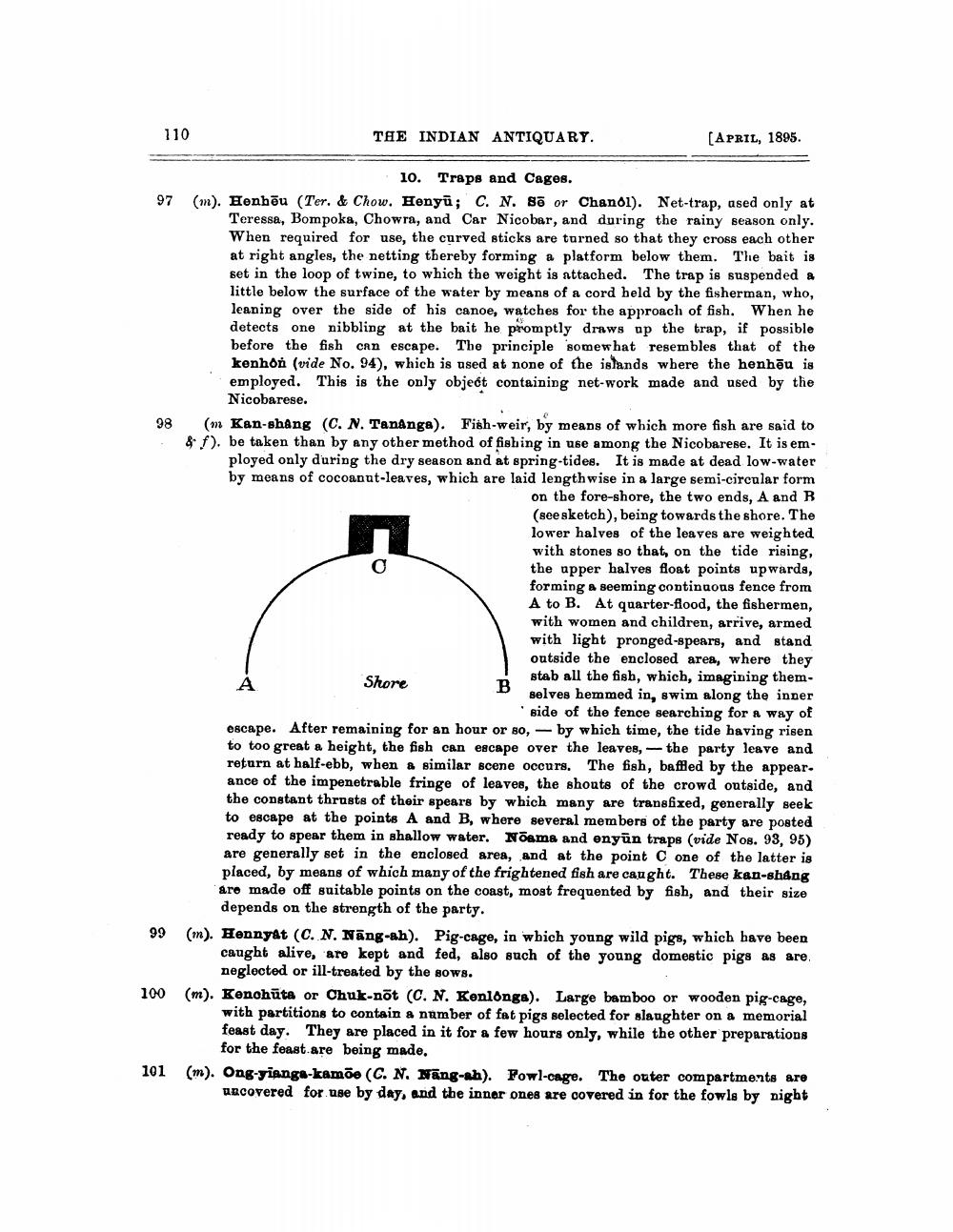________________
110
THE INDIAN ANTIQUARY.
[APRIL, 1895.
97
38
10. Traps and Cages. (on). Honbõu (Ter. & Chow. Henyü; C. N. 87 or Chanol). Net-trap, ased only at
Teressa, Bompoka, Chowra, and Car Nicobar, and during the rainy season only. When required for use, the curved sticks are turned so that they cross each other at right angles, the netting thereby forming a platform below them. The bait is set in the loop of twine, to which the weight is attached. The trap is suspended a little below the surface of the water by means of a cord beld by the fisherman, who, leaning over the side of his canoe, watches for the approach of fish. When he detects one nibbling at the bait he promptly draws up the trap, if possible before the fish can escape. The principle somewhat resembles that of the kenhoń (vide No. 94), which is used at none of the islands where the henhễu is employed. This is the only object containing net-work made and used by the
Nicobarese. (m Kan-shang (C. N. Tananga). Fish-weir, by means of which more fish are said to & f). be taken than by any other method of fishing in use among the Nicobarese. It is em
ployed only during the dry season and at spring-tides. It is made at dead low-water by means of cocoanut-leaves, which are laid lengthwise in a large semi-circular form
on the fore-shore, the two ends, A and B (see sketch), being towards the shore. The lower halves of the leaves are weighted with stones so that, on the tide rising, the upper halves float points upwards, forming a seeming continuous fence from A to B. At quarter-flood, the fishermen, with women and children, arrive, armed with light pronged-spears, and stand
outside the enclosed area, where they Shore
stab all the fish, which, imagining themselves hemmed in, swim along the inner
side of the fence searching for a way of escape. After remaining for an hour or so, - by which time, the tide having risen to too great a height, the fish can escape over the leaves, the party leave and return at half-ebb, when & similar scene occurs. The fish, baffled by the appear. ance of the impenetrable fringe of leaves, the shouts of the crowd outside, and the constant thrusts of their spears by which many are transfixed, generally seek to escape at the points A and B, where several members of the party are posted ready to spear them in shallow water. Noama and enyün traps (vide Nos. 93, 95) are generally set in the enclosed area, and at the point one of the latter is placed, by means of which many of the frightened fish are caught. These kan-sháng are made off suitable points on the coast, most frequented by fish, and their size
depends on the strength of the party. (m). Hennyát (C. N. Nāng-ah). Pig-cage, in which young wild pigs, which have been
caught alive, are kept and fed, also such of the young domestic pigs as are,
neglected or ill-treated by the gows. (m). Konohüta or Chuk-nõt (C. N. Kenlonga). Large bamboo or wooden pig-cage,
with partitions to contain a namber of fat pigs selected for slaughter on a memorial feast day. They are placed in it for a few hours only, while the other preparations
for the feast are being made. (m). Ong-yianga-kamõe (C. N. Nâng-eh). Fowl-cage. The outer compartments are
Uncovered for use by day, and the inner ones are covered in for the fowls by night
99
100
101




